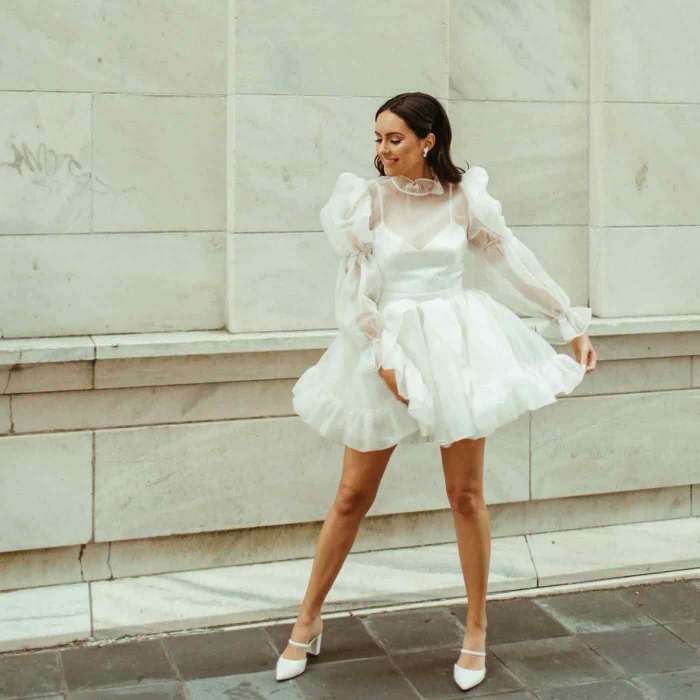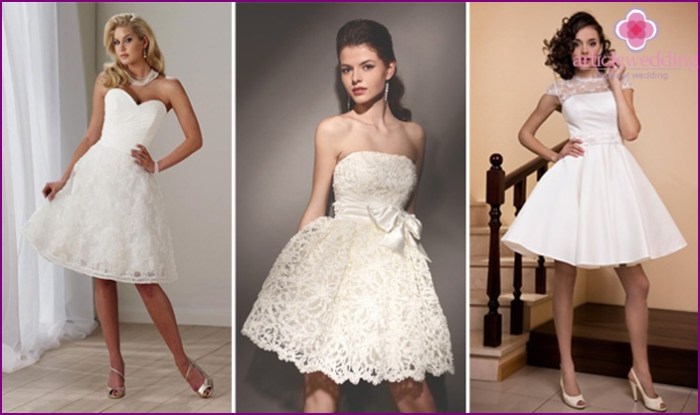Short to Long Wedding Dresses A Style Guide
The Timeless Allure of Short and Long Wedding Dresses: Short To Long Wedding Dress

Source: greenweddingshoes.com
Short to long wedding dress – The choice between a short or long wedding dress is a significant one, reflecting personal style, venue suitability, and the overall vision for the big day. This exploration delves into the history, aesthetics, practicality, and modern interpretations of both lengths, offering a comprehensive guide for brides-to-be.
The Evolution of Wedding Dress Lengths
Wedding dress lengths have undergone a fascinating evolution, mirroring societal shifts and fashion trends. From the floor-length gowns of the early 20th century to the more diverse options available today, the hemline tells a story.
| Era | Style | Description | Illustrative Details |
|---|---|---|---|
| Early 1900s | Floor-length, Edwardian | Long, flowing gowns with high necklines and long sleeves, often featuring intricate lace or embroidery. | Think delicate lace, high necklines, long sleeves, and a full, flowing skirt. Silhouettes were often A-line or empire waist. |
| 1920s | Short, Flapper-inspired | Dropped waistlines, shorter hemlines revealing ankles or calves, often beaded or sequined. | Short, straight or slightly A-line dresses with dropped waists, often featuring embellishments like sequins or beads. The overall look was sleek and modern. |
| 1950s | Full, Tea-length | Full skirts, often made of satin or tulle, with cinched waists and varying necklines. | Think full, voluminous skirts, cinched waists, and a tea-length hemline (falling mid-calf). Often featured petticoats for added volume. |
| 1960s-Present | Varied lengths | A diverse range of styles, including mini dresses, tea-length, and floor-length gowns, reflecting individual preferences. | This era showcases a wide variety of styles, from simple sheath dresses to elaborate ball gowns, with hemlines ranging from mini to maxi. |
Societal factors such as economic conditions, women’s roles, and evolving fashion trends heavily influenced these changes. The flapper era, for instance, saw shorter hemlines reflecting a newfound freedom and independence for women.
Short vs. Long: Bridal Aesthetics
The choice between a short or long wedding dress dramatically impacts the overall aesthetic. Each length evokes a different mood and lends itself to various styles and settings.
Short dresses often project a sense of playfulness, modernity, and ease. Fabrics like silk crepe, lace, or cotton are frequently used, sometimes paired with delicate embellishments such as beading or embroidery. Long dresses, conversely, exude elegance, romance, and tradition. Fabrics such as silk satin, tulle, or lace are commonly used, with embellishments ranging from intricate beadwork to delicate appliqués.
The length significantly impacts the overall wedding look. A short dress might suit a casual beach wedding, while a long gown would be more appropriate for a formal ballroom setting. Body type also plays a role; shorter dresses can flatter petite figures, while long gowns can enhance taller frames.
Practical Considerations for Short and Long Dresses

Source: articlewedding.com
Practical considerations are crucial when selecting a wedding dress length. Comfort, movement, and ease of dancing are key factors to consider.
| Factor | Short Dress | Long Dress |
|---|---|---|
| Comfort | Generally more comfortable for movement and dancing. | Can be less comfortable for movement and dancing, especially with long trains. |
| Movement | Allows for greater freedom of movement. | Can restrict movement, especially with long trains. |
| Footwear | Allows for a wider variety of footwear choices. | Often requires heels to avoid tripping hazards. |
| Beach Wedding | Ideal; easy to move in sand. | Can be cumbersome and difficult to manage in sand. |
| Ballroom Wedding | May feel less formal. | Classic and elegant choice. |
| Garden Wedding | Suitable; allows for easy movement among plants. | Can be beautiful but requires careful consideration of the terrain. |
Styling and Personalization
Both short and long wedding dresses offer a multitude of styling options, allowing brides to express their unique personalities and preferences.
Styling choices for both lengths are incredibly diverse. Necklines can range from simple V-necks to elaborate sweetheart necklines or high necks. Sleeve styles vary from sleeveless to long sleeves, capped sleeves, or off-the-shoulder styles. Trains can add drama to long gowns, while shorter dresses can be paired with boleros or jackets for added flair. Accessories like veils, jewelry, and headpieces further enhance the overall look.
- Bohemian: Flowing fabrics, lace details, floral accents (both lengths).
- Classic: Simple silhouettes, elegant fabrics like satin or silk, minimal embellishments (both lengths).
- Modern: Clean lines, geometric patterns, unconventional fabrics (both lengths).
- Romantic: Soft fabrics like tulle or chiffon, delicate lace, flowing silhouettes (both lengths).
Modern Interpretations and Trends, Short to long wedding dress
Modern wedding dress designers continue to push creative boundaries, offering innovative designs for both short and long gowns. Current trends include a resurgence of vintage-inspired styles, the incorporation of unconventional fabrics, and the use of bold embellishments.
Modern Short Dress 1: A sleek, mini A-line dress in a bold jewel-toned silk with a plunging neckline and subtle beading along the bodice. The silhouette is simple yet striking. Modern Short Dress 2: A playful, high-waisted mini dress in embroidered cotton lace with puff sleeves and a ruffled hemline. The overall look is whimsical and romantic. Modern Short Dress 3: A structured, fitted mini dress in a modern geometric print with a high collar and long sleeves.
This dress exudes a confident and edgy vibe.
Modern Long Dress 1: A flowing, empire-waist gown in lightweight silk chiffon with delicate floral appliqués scattered across the skirt. The overall feel is ethereal and romantic. Modern Long Dress 2: A structured ball gown in luxurious silk satin with a dramatic, off-the-shoulder neckline and a subtle train. The dress exudes classic elegance. Modern Long Dress 3: A modern sheath gown in a bold color-blocked design with a high slit and a minimalist silhouette.
The choice between a short or long wedding dress is largely a matter of personal preference, reflecting the bride’s style and the formality of the event. For guests, however, finding the perfect attire can be equally important; a stunning option might be a luxurious satin dress wedding guest outfit, which offers elegance and sophistication. Ultimately, whether you’re the bride or a guest, the key is selecting an outfit that makes you feel confident and comfortable.
This dress is chic and contemporary.
FAQ Section
What are some popular short wedding dress styles?
Popular styles include A-line, tea-length, fit-and-flare, and high-low designs. The choice depends on personal preference and body type.
How do I choose the right length for my body type?
Shorter dresses can be flattering on petite brides, while taller brides can carry off longer gowns beautifully. Consider your proportions and what makes you feel most confident.
Can I wear a short dress to a formal wedding?
While traditionally long dresses are associated with formal weddings, a well-styled short dress can be perfectly appropriate, especially if the overall look is elegant and sophisticated.
What accessories work well with short wedding dresses?
Statement jewelry, stylish shoes, and perhaps a shorter veil or hairpiece can complement a short dress beautifully. Consider the overall style of the dress when selecting accessories.



















